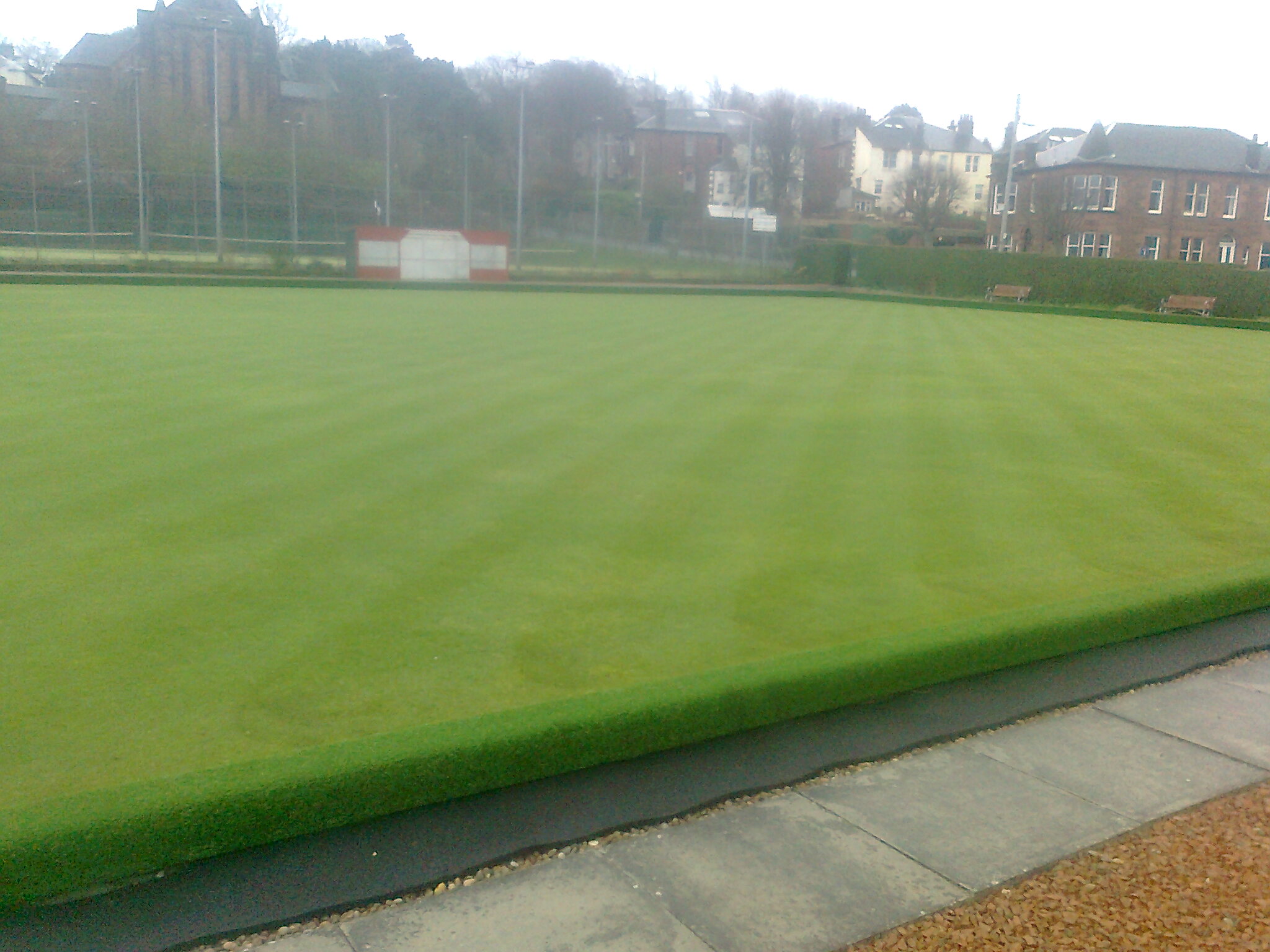
A Definitive Guide to Maintaining a Bowling Green
Introduction
This article is designed to enable even the least experienced volunteers or green keepers in bowling clubs to follow a plan of action to maintain the bowling green in good condition throughout the season.
In conjunction with the article I have negotiated a package of the fertilizers and other treatments which I would recommend to carry out the advice I will be offering. This package is very competitive and will enable the bowling clubs to budget for the year ahead knowing exactly what the required funding will be. We can also supply all materials in the package on an individual basis, although delivery costs will be a little higher.
With the package you will also get ongoing advice by telephone or e-mail, and help in sourcing all other materials and machinery. If you’d like more details, or to talk it through, get in touch.
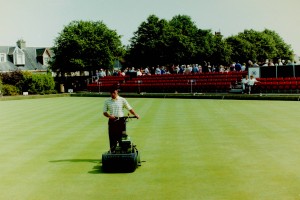
Mowing
Mowing is the single most important operation in maintaining a good surface. The mower has to be a specialised fine turf mower with at least ten cutting blades, there are no cheap alternatives.
There are a variety of manufacturers and a huge difference in pricing. The Dennis has the advantage of interchangeable cassettes for various tasks, such as spiking, verti cutting, scarifying, and rolling.
The easiest mower, in my opinion, to use and set, and also very good value, is the Lloyds paladin, this comes with an optional brush and comb set, very much recommended, which are both very useful in providing a good playing surface. There are a good number of options available, Toro, Baroness, and Dennis, among them. Shop around and get demos for best option for you.
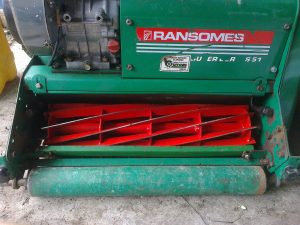
I do not advise bowling clubs to spend the substantial additional funds on a groomer attachment as these are difficult to set, and can cause problems if not used properly. A good second hand scarifier/verticutter can be bought for less, and is far more versatile.
The cutting cylinder and bottom blade must be in good condition and sharp, then set to achieve a clean cutting action.
Blunt or badly set mowers are the primary cause of poor bowling surfaces as it causes uneven growth and tears the leaf tips allowing disease to thrive, and also stunts regrowth.
In most cases the machine will need a sharpen, and possibly even a new bottom blade, halfway through the season to retain a good finish.
It is always worth having a back up machine in case of break downs, and also to cover during servicing etc.
Checking the blades.
The cutting action can be checked easily by carefully inserting a piece of writing paper between the cylinder and bottom blade, then turning the cylinder very carefully by hand. The paper should cut cleanly along the length of the blade, if not it certainly wont cut the green properly.
With the mower properly set for cutting, the height of cut is the next step at the start of the season. The aim is to have the green being cut at no more than six mil by the end of March, so if the mower is set above that, then over the last two weeks in March lower the height by a half mil at a time till the six mil is reached.
I would hope to be mowing at least twice a week at this stage, depending on weather of course. In the South of the UK the timing can be as much as two weeks earlier so take your location into account.
Mowing direction should be from corner to corner, although the angle can be varied a little, alternating between corners on each cut, during the playing season. In the close season the direction should be altered to four different directions including straight up and down and across the way to eliminate any nap, grass lying in one direction causing runs on the green (see verti-cutting to avoid this), that occurs during the season.
Attaining optimum cutting height.
To check the height of cut a straight edge is set between the front and back rollers, the bench setting of the cutting height being the space between the straight edge and the edge of the bottom blade nearest to the cutting cylinder(see pic).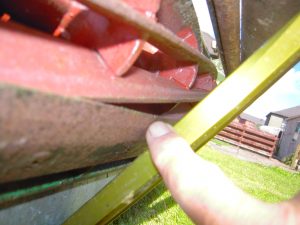
I say bench setting, as that is not necessarily the true cutting height as that depends on how firm the green surface is. On a soft, thatched surface the bench setting will be higher to compensate for the mower sinking slightly into the surface. This can only be assessed by trial and error.
Most new mowers come with a setting bar, that is a straight edge with a screw through it which slips onto the inside of the bottom blade to help with setting. You can also get specialist setting gauge, with a visable gauge. Much more expensive, so depends how much you have to spend.
Early April
Over the first two weeks of April the cutting height should be lowered by a half mil each week, with frequency upped to three times per week. Whether it goes lower than 5 mil later in the season depends on many factors, examples being whether members like slow or fast greens, or that fine grasses such as fescue bowl well at five mil, whereas annual meadow grass has to be cut shorter to get a fast true surface.
For the rest of the season the height can be varied slightly up or down depending on weather and/or speed requirements. Cutting frequency should be maintained at a very minimum of three times per week, although it has to be noted that the more often mowing is carried out the better the surface will be.
At the end of the playing season the mowing height should be increased to a maximum of eight mil, and the green given a trim whenever the weather permits throughout the Autumn and Winter. This helps to keep the surface dry and reduces the possibility of disease outbreaks.
Scarifying
What is scarifying.
Scarifying is the act of using vertically rotating blades to cut into the surface of the green to remove dead and dying material known as thatch and fiber. This opens up the sward, letting in air, and also vertically prunes the grass plants which stimulates fresh strong lateral growth. Scarifying should never be carried out in the Winter months as exposing the grass crown, the growing point, to frost, can cause serious damage and even death of the plant.
There are various methods of scarifying bowling greens, they are thatch removal, thatch control, and grooming, the last of which is a small vertical cutting reel fitted in front of the mowing reel on the mower.
The thatch removal reel is quite severe on the sward so is best only used in the Autumn during the renovations, and possibly in early Spring before the start of the season if there is a thatch problem. In the Spring the recommended method is to carry out the first operation of verti cutting around two weeks after the application of the early spring fertilizer in mid to late March.
This ensures any moss has been killed for easy removal, and the grass is vigorous enough to fill in very quickly. This operation is fine to carry out straight across the green.
Regular in season verti cutting.
If you have your own scarifying machine then verti-cutting should be carried out ideally every two to three weeks throughout the season, except for periods of drought when the grass is stressing. Alternate the direction between opposite corners each time.
Alternatively, verti-cutting units can be hired in, and it will be down to budget restraints as to how often the work is done. In the close season verti-cutting or scarifying can be carried out in straight lines across the green.
If a groomer is fitted to the mower then it should be set at around two mil above the cutting height for optimum effect, but only used when the grass is not under stress from drought. If verti-cutting is not being carried out then the groomer can be set more aggressively, but no lower than one mil above the cutting height.
Fertilizers and Conditioners
Why they are needed.
Fertilizers are applied to supply nutrients to the grass plants to help them grow healthily and withstand the wear and tear of feet, bowls and machinery. Conditioners are materials such as seaweed that help the plants to take up the nutrients by improving the soil through increasing the microbial and bacterial content in the soil, and also supplying many micro nutrients, thereby giving a much healthier growing medium. This ultimately means less fertiliser is require overall.
Spring
The first application of fertilizer should be applied around mid to late March during the first spell of mild weather, again in the South of the UK this can be earlier. A good sign for the inexperienced groundsman to look out for when the time is right is the farmers feeding their fields, one of the only times you would ever follow farming methods!
On bowling greens the fertilizer should contain a good iron content to kill any moss for easy removal, and no phosphate or potassium. My preferred formula is 9 to 12% nitrogen, and at least 9% iron. This will read as 10.0.0. 9%fe or similar on the product description. A good quality spreader such as this one is required for all granule or powder products.
During the season
I prefer to use liquid fertilizer during the season as it does not interfere with the bowling in any way, granules and powders are very messy, sticking to bowls and shoes, and can stain badly. My preference is to apply a liquid containing nitrogen, some potassium, and seaweed around the start of May, then the same again at six week intervals until the middle of August.
At around half way between each of the fertiliser applications, apply a conditioner, I would recommend one that is seaweed based. For example, this Maxicrop conditioner is a proven high quality seaweed extract. But there is also a very good one on our own shop now, with added humic acid.
This can be supplemented by applying liquid iron, or chelated iron (find a good liquid iron supplement here) along with the conditioner, this keeps moss under control, and adds colour without forcing growth. Care must be taken not to apply iron when the grass is drought stressed as this can cause damage by scorching.
In a wet season the frequency may have to be increased to compensate for leaching out of the nutrients, and of course this applies to varying weather patterns in different parts of the country.
Autumn/Winter
During the Autumn renovation my recommendation is to use a low nitrogen/high potassium feed, with micro nutrients, iron and seaweed(find a good example here) to stimulate a slow and strong recovery from the seasons stresses. Over the Winter period two applications of lawn sand, the first around late November, the second early February, are recommended to harden the grass and keep moss at bay. Soluble iron sulphate, at five kilo per green, although a bit harder work to apply, is much cheaper, and in my opinion, more effective. This is available on the lawnsforyou shop.
Wetting agents
Wetting agent is used to increase the rate at which water disperses and is a very useful tool in helping to avoid flooding, or heavy dews forming. When added to liquid fertilizers it helps the plant to absorb the nutrients quickly so avoiding loss by evaporation.
Wetting agent should be added to each spray application of fertilizer and iron at half the recomended full rate. The other time to use wetting agent is immediately after the autumn renovation as it aids seed germination and grass recovery after aeration, this time at full rate.
See the specific articles on best fertilizers for the types recommended in each season.
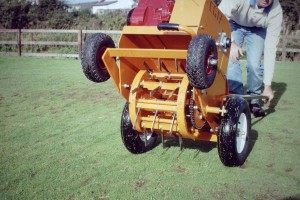
Aeration
Why aerate
Air in the root zone is essential to the health of the grass plants that make up the playing surface as the spaces are where the roots grow and absorb the nutrients required to produce a quality surface.
Aeration is also essential to allow water to penetrate the surface and drain through the root zone without water logging and consequently drowning the plants.
Methods used
The most effective method of aerating is by slit tining, ideally alternating operations between depths to avoid forming a compacted pan at one level. The frequency of aeration depends a lot on the greens root zone make up as, for instance, sand naturally drains much faster than loams or clay soils. Sand root zones do not compact as badly or as deeply as the others either.
I prefer to use a combination of deep slitting, six to eight inches, every month from October to March, and chisel tines alternately in each of these months in the two weekly gaps between the deep spiking. Over the Summer months the chisel tines, or solid pencil tines, can be deployed once per month to keep the surface open as there is no danger of these opening up because of dry weather.
If a sarrell roller, a roller with lots of small spikes around two to three centimeters long, is available, it should be used every two weeks or so throughout the season. It is important to always spike in the same direction, especially with the deeper slitting tines, as this has been proved to be the most effective in producing good root growth, and avoids damage to the turf by cross hatching. Always spike in straight lines across the green as there is much less turning required, and it is much quicker.
The other methods of aeration are verti-draining and hollow coring. I only recommend hollow coring if there is a very serious thatch problem, or the soil is very heavy requiring modification to improve drainage, and should only be used as part of the Autumn renovation program. Hollow coring is certainly not required on a sand based root zone. Hand tools to carry out operations on worn areas are very useful on any green. If a specialised tool is not available, a garden fork inserted vertically, then eased back to lift the soil works well.
Verti-draining is a deep operation using 30 centimeter solid spikes and heaving the soil as you would do with a garden fork. It is very effective for deep seated compaction on heavy root zones, but there has to be underlying drainage in place or it will not work, and in fact can make things worse by further saturating the root zone as the water has no where to go.
If verti-draining is recommended then is should be as part of the autumn renovation along with slitting or hollow coring. The verti drain is a tractor mounted machine, so before booking this you must ensure access to the green is possible.
Water Application
Watering turf can be a very contentious subject as there are so many variables.
When watering fine turf the object is to keep the grass alive, not necessarily keep it bright green, as to do that would lead to a soft easily damaged surface and very shallow rooting.
Automatic watering systems are great when used properly, but since their introduction have lead to many severe problems, particularly when being controlled by amateurs who only think it can be switched on every night with no idea of the consequences.
The aim should be to soak the root zone thoroughly every three days or so to ensure the grass roots are kept supplied with moisture. This is where spiking and wetting agent are great allies as they allow the water to get into the root zone quickly, thereby reducing water usage and providing a much healthier playing surface.
If the temperature is very high, then a short one minute spray during the day can help to cool the turf canopy, and the soaking could be increased to every second night.
It is best to water early in the night as far less water is lost into the atmosphere during the cool of the night.
Rolling
In direct opposition to aeration, rolling does cause compaction, irrespective of which kind of roller is used. Rolling does produce a faster, truer surface, but should be used with caution, especially if frequent spiking is not being carried out.
The pedestrian tru level roller is a good tool, having three rollers to spread the weight, but is labour intensive, really only suitable for use before big competitions. The motorised version of this is heavier, but because of the three rollers spreading the weight, is a valuable tool to speed up the green on a weekly basis, again as long as aeration is regular.
If not owned these can be hired for big competitions if speed is required. I would not advise the big single rollers other than just before the start of the season because they roll into and over undulations and do not level in any way.
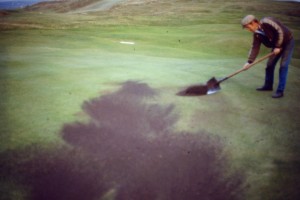
Top Dressing
Top dressing serves two purposes. First it is used to dilute the build up of dead and dying grass material in the top two or three centimeters of the green which prevents the build up of thatch, and spiking then takes some of the top dressing down into the root zone, both of which aid drainage to keep the surface dry and healthy. The second purpose is to keep the surface level by using a straight edge to smooth out any abnormalities.
I always advise using a medium course top dressing that has been properly tested. My preference in most situations is to use a straight sand dressing as this does away with the unavoidable variances in organic content, and the drainage characteristics are consistent throughout. I can advise on your nearest approved supplier.
The main times to use top dressing is in the Autumn to finish off the Autumn renovation, when the the application can vary from three tons to six tons per green depending on whether the green has been hollow cored/verti-drained, or only been spiked, and also on the budget available as top dressing is liable to be biggest single expenditure on materials for the green.
In the Spring, well before play commences, playing heads should be given a dressing at a kilo or so per square meter. A supply of dressing should be kept in stock to allow the heads to be dressed once a month throughout the season to help them withstand the wear and tear of play.
General
It is good practice to apply good quality grass seed, particularly on the heads, after aerating and before top dressing, during the Autumn renovation. The rate for over seeding is recommended at twenty five grams per square meter, and should be a mix of grass types suitable for producing a first class bowling surface. I deal with a very reputable seed supplier who, being a family company, provide an excellent choice of grasses fit for purpose.
I have not mentioned any disease or pest problems as these are best dealt with as a separate issue. Disease, mainly fusarium, can cause a serious problem, but I personally have not used a fungicide for more than forty years, as the practices I recommend are designed to produce a healthy grass sward that is not prone to disease. Some patches will occur but are easily dealt with by using iron and top dressing. I can advise on more serious occurrences if disease is already present due to past practices.
Worms can cause a lot of problems, particularly on heavier soils. Regular switching and/or brushing is essential throughout the year, especially before mowing. There are some chemicals available which I can advise on if required (contact me here). Worms do not like iron, do not like sand, and are not nearly as active in well aerated soils, so my maintenance program greatly discourages worm activity.
The only other pest that causes serious damage in turf is the leatherjacket, the grub of the cranefly, which eats the roots and shoots of grass plants, resulting in death of the grass in the worst cases. There is often also the more serious damage caused by birds and animals digging and scraping the surface looking for food.
Very cold Winters will reduce the population, and there are now no insecticides available for control. Nematodes are being experimented with, but are expensive and not yet proven to work. Best method is to ensure the sward is healthy, with a good root structure, to withstand the attacks better.
It is possible to remove them manually by applying a heavy dose of wetting agent after aeration, then flooding with water, which will bring them to the surface where they can be removed by brushing or mowing. Adding a cover overnight, such as a tarpaulin, will be even more effective.
Weeds
Weeds can be a problem, particularly if using top dressing containing soil or if hollow coring often. I do not advocate ever spraying a full green with weedkiller as it certainly sets back the grass a little at the same time. Most weeds can be lifted out by hand, using a grubber or small fork, but if there is an infestation of ground hugging weeds, like chickweed or pearlwort for instance, spraying with a readily available selective weedkiller (this one from Westland) would last 2 or 3 applications(used selectively by spot treating) using a hand held spraying bottle will do the job. If you require advice on this please get in touch.
One of the biggest problems I see on bowling greens is a reluctance to regularly move the heads to spread the wear. There should be at least three settings in each direction on any standard sized green, with these being changed on a set rota to ensure an even spread of wear throughout the season.
I always advocate a single circuit round the edge of the green with the spare mower set at around seven to eight mil to protect the green edges. This is legal in the rules, and is good practice, but can only be done easily if a spare mower is available.
As I have said this is a definitive guide to maintaining a bowling green but in many cases the ground conditions, weather, and surrounding issues such as big trees will entail altering or modifying a program to produce the best playing conditions.
This is where an initial assessment and on going advice can be greatly beneficial to any bowling club using our service. If you want to talk it through, please do get in touch.

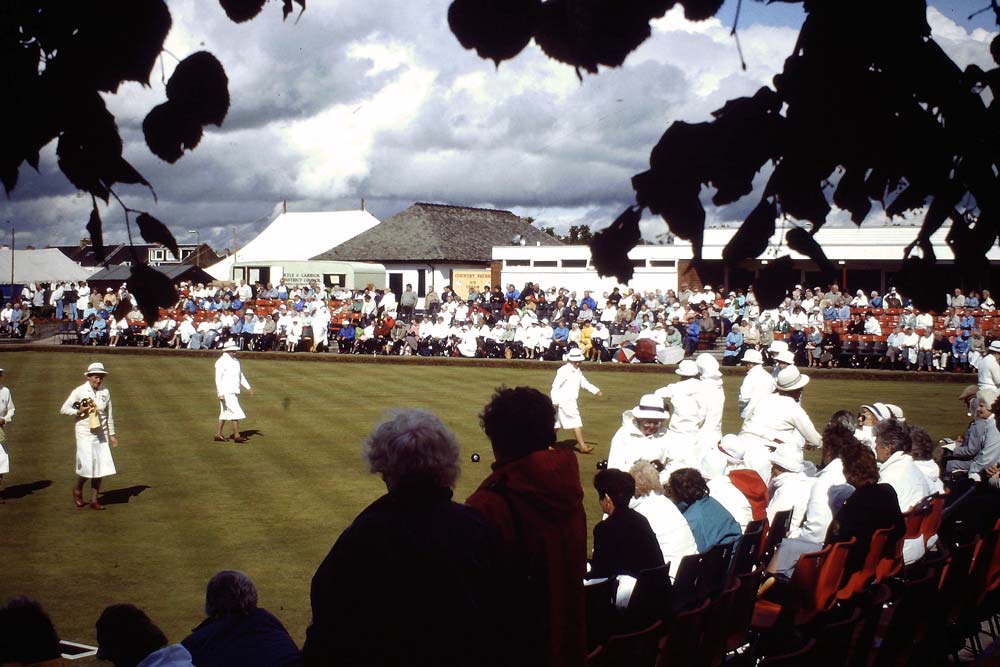
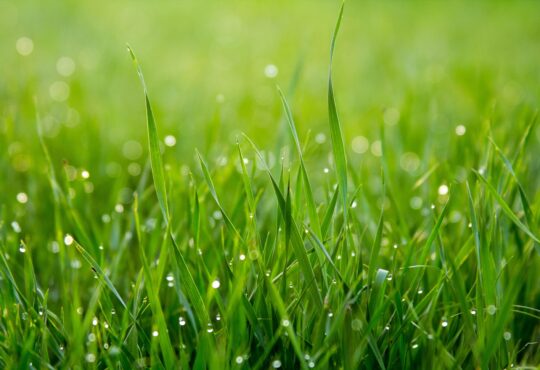
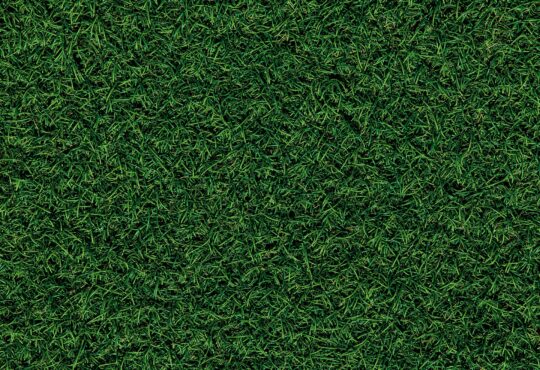
Hi. We have just had our bank renewed round the bowls green but did not mark out the rinks or colors for even ware.
which is the best way to set it up again! as it is off line and is bowling very poorly.
My idear was measure out six rink,then find centre of each rink..
then the colors each side of center,,,,how far apart would the colors be each side of center.
Look forward to your reply
yours faithfully
George.
Hi George,
Assuming you are on a full sized green I would measure out the six rinks in each direction, leaving an equal amount of room at each end. From there mark the center points of each rink. Colors are the best way to mark the movements, with three normally enough. Depending on how much room you have try to give a minimum of one yard either side of the centers, a little more if you can, as the more wear is spread the easier it is to retain a good surface.
I hope this helps you.
Duncan.
Hi Duncan, I was wondering if you could advise me on the best way to maintain our bowling green located in the Pilbara ( Dampier ) where average temperatures range from 35-45degrees daily.Unfortunately we don’t have a greenkeeper any longer due to financial restraints and the downturn of employment in our town but still have many keen bowlers.Any advice is most welcomed and much appreciated. Regards Wally(President) P.S Should i water the bowling green after mowing?
Hi Wally, thanks for getting in touch.
I had a look at your area on google, it looks really nice, and hot!!
For the most part maintenance practices are the same the world over, with the main difference being in the watering regime in tropical climates.
Wetting agents and sarrell rolling , lots of little spikes, are important on a monthly basis, to ensure the water penetrates the rootzone quickly before it avaporates.
Normal practice would be to water late evening, and early morning, then during the day when very hot syringing, a light short spray, to avoid leaf wilt.
Have a look at my bowling green maintenance schedule on the lawnsforyou.com website for a typical years program, then get back to me with any questions.
Duncan.
We have a bowling green with a pea shaped gravel no longer available. We have to keep hoeing the gulley which is a long job in the growing season. We would like to know about the best way to make gullet better and easier to look after but not too expensive. Thank you and look forward to any suggestions you might have.
Hi Margaret, sorry for the long delay, we have been having problems with communications. Sorted out now though hopefully.
I have discovered the perfect solution to your problem. It is a rubber ditch liner, fully approved the bowling authorities, produced by Clifton rubber, 01480496161. It comes in one meter sections so is ideal for any bowling green.
Happy bowling,
Duncan.
Overton Park Bowling Club Rutherglen
Can you please advise us on a supplier of the straight sand dressing you mention in this article
and is there a code for this product
Hi Allan,
Thanks for getting in touch. Levenseat in Fauldhouse, 01698870970. The medium course sand dressing is excellent.
we have just been handed back our green by our bowls club and it is in a bit of a state. lots of moss on it. it was not treated with anything last season. what is our best action to bring it back to its best.
Hi Duncan, I was wondering if you could advise me on the best way to maintain our bowling green located Zambia on the Copper belt Province. The average temperatures range from 32-38 degrees daily. This year we had a particularly poor rain season which saw our greens almost dying. Fortunately we managed to sink a bore hole and saved the greens. However we still have challenges to make it up to standard in terms of playing surface etc. Please advise us on the best approach to improve on the playing surface.
Regards
Hi Michael,
For the most part maintenance practices are the same the world over, with the main difference being in the watering regime in tropical climates.
Wetting agents and sarrell rolling , lots of little spikes, are important on a monthly basis, to ensure the water penetrates the rootzone quickly before it avaporates.
Normal practice would be to water late evening, and early morning, then during the day when very hot syringing, a light short spray, to avoid leaf wilt.
Have a look at my bowling green maintenance schedule on the lawnsforyou.com website for a typical years program, then get back to me with any questions.
Duncan.
Hi Duncan we empty our water tank every year in case of frost . The thing that I don’t agree with is they have been emptying it onto the green each year in November. The last thing our green needs is 200 galls of extra water going on our green every year .itwas absolutely sodden .please tell me that they are not doing the green any good .
Hi Ian, yes you are right. I find that actually very difficult to understand. Ideally the green needs to be as dry as possible, in Autumn and Winter especially given our rainfall, to help avoid disease, and encourage deep rooting fine grasses. That is why regular spiking to aerate the green is essential. Whoever decides to empty onto the green has no concept of green management I would suggest.
Duncan.
Hi Duncan
We have two bowling greens in Walvis Bay in Namibia and in the past season the greens both showed signs of heavy stress with large areas dying. We use effluent water as fresh water is too expensive. The soil used for top dressing is sifted river sand as the sand particles are large. Some members are insisting that I should use dune sand that is plentiful as we are on the edge of the Namib desert, I am however of the opinion that dune sand should be avoided at all costs as the sand grain is to fine and will add to our compaction problems.
I would appreciate your thoughts please
regards
Brian Peake
Hello Duncan
Happy new year….My problem is we recently had the wooden green banking renewed,we had marked the heads but they are/have been askew (not straight,no two sides of green are same length,so measurements are not square ie look off.Is there some easy way to set up the rink markers to ensure that standing on mat,the jack is square.I hope I`ve explained it clearly
Aye yours
Charlie D.
Hi Charlie,thanks for getting in touch.
It is always a little awkward to set up a green that has uneven sides. What I would suggest is to use strings to mark out a square using the shortest side as the base length. You will then have four equal sides, with the strings at some stages a fair distance from the longer sides, depending on the length differences of course.
What you do then is to form a T bar from two pieces of wood, measure the rinks on the marked out square, and use the T bar to extend the marks onto the green edgings.
This should then give you straight rinks in whatever direction you are playing.
I hope this helps, but if you need more explantion then please get back in touch.
Duncan.
Hi Brian,
Thanks for getting in touch.
I have not got first hand experience in your situation, but have many contacts who have.
The first thing I would say is that I have had a look at your area on google maps, and can`t see where the river you use is situated, but would guess you are close to the sea, so the first question is that of possible salt content in the sand extracted. Although the particle size may be more suitable, salt will cause large scale damage to any grass.
Desert sand is very round and does not compact easily, even though it is fairly fine in nature, but can contain a lot of organic matter which is not obvious, so I would advise getting an analysis of both before deciding on future use.
As a matter of interest, have you checked with the golf course as to what they use to dress greens.
The use of effluent water is widespread, and the problems that can occur well documented. The most important thing to do is constant testing of the water quality to ensure a consistant supply, and stop immediatly to rectify the polutents if readings are to high.
Using materials in the maintenance regime such as seaweed meal and liquid, and making compost teas, will increase the soil flora and fauna thus enabling them to nullify a lot of the effects of pollutents.
I am taking it you have a filter system in place before using the water. If not, it is worth setting up a simple system in which you could use a desert sand filter bed which would certainly help the water quality.
If you can give me a few more details of your situation, I will be happy to expand on these answers.
Duncan.
Duncan
Hillside Bowling Green Montrose
Sorry it has taken so long to come back since my last contact.
The scarifier we have is a Sisis Rotorake Mk 5
Hi Ian,
I have had a lot of computer problems, but now have a replacement up and running so am operational again.
The SISIS is a good machine, and hopefully you have the various attachments to go with it.
I will be up in Dundee visiting my son next week so would be happy to take a wee run up to see you as I am going to see Angus horticulture, halfway between you and Forfar anyway.
I would not charge for a visit. If you have a read at my article, “The definitive guide to maintaining a bowling green”, before I arrive, you can then have any questions ready for me.
Let me know if this is of interest.
Duncan.
Hi Duncan,
We have recently moved to new green (new to us) which has not been played on for the past two years. In that time it has been at least mowed by the local council. I say at least as I am not sure that any other work has been carried out. It plays very erraticly, very uneven, making it difficult to keep a consistent line. If we give it a roll, mid season, would this be worthwhile or would it cause more problems than it solves? Would appreciate your advice.
Ivan Stevenson
Hi Ivan,
The reason it is playing like that is most probably because it has not been mowed regularly, and to a decent playing height, over these two years.
This would produce a thatchy soft surface that will take some time to return to a good firm playing surface.
Regular cutting, ensuring the mower is sharp at all times, is essential. At least three times per week, even four if you can. More cutting produces a progressively better surface.
Combine the cutting with weekly vertical cutting, light applications of liquid fertiliser that includes seaweed, and roll once per month over the Summer, then you should see some big improvements to the green.
The Autumn maintenance, which should include top dressing with a good quality sand, is an essential part of the years program to produce a good green for the following year.
I have a comprehensive maintenance plan here on my website for bowling greens that should help you progress.
Please get back to me if you have any further questions.
Duncan.
Hi Duncan, very interesting article.
I don’t personally like the 7/8 mm at the edge of the green as it holds up the jack which may otherwise have just tipped into the ditch. Also can influence a bowl in the same way. I suppose you refer to players always standing on thee edges which will cause wear ?
Hi, It’s snowing heavily here. Should I remove the laying snow (predicted to remain for 4 days) or should I just leave it to melt naturally?
Hi Phil, just leave it to melt as the labour required is not justified. Snow also carries with it a lot of nutrients, so is actually very useful for the health of the turf. Cheers, Duncan.
Hi Duncan.
We use and maintain a council green, it’s a bit slow which is ok not great but ok. Over the past few years it has stopped draining so well and is compacted in places.
What would you recommend.
Also while we are maintaining the green we may be looking for professional advice over the season.
Thanks david
Hi David, lack of drainage is usually due to lack of aeration. Solid and slit tining, and regular scarifying/verti cutting are necessary to keep thatch under control, and let water drain through quickly. Using wetting agents, along with a liquid feeding regime, is also a great help.
I would be happy to help you with a full maintenance program. Let me know where you are and I can arrange to visit you whenever is suitable.
Duncan.
Hi Duncan what qualifications does a greens person require to use chemicals on a bowling green cheers Kent
Good morning Duncan. I am the green keeper at my bowls club. We have just purchased a Groundsman Airator. During the summer
we used to use a Sorrel roller and used it from corner to corner. When we had a demonstration I started using it diagonally and the
man said that because of the action of the machine he recommended that we should go up and down is this correct. Also should we
always go in the same direction or alternate.
Hello Duncan, There has been much discussion at my Bowling Club about whether it is necessary to brush off the dew early each morning. Can you advise? Our club is in Hampshire. Many thanks.
Removing dew is an essential if not mowing or rolling. leaving on the grass can encourage disease and worm problems.
Cheers, Duncan.
Hi Duncan,
We’ve had a company trying to sort patches on our green for 10 weeks. They have tried everything and keep coming back and saying it’s tree roots (which were cut last year). They have reseeded these patches and the entire green umpteen times but blame the birds for eating the seeds. Some of the seeds were used off site and nurtured but still did not germinate.
Do you have any suggestions.
Many thanks.
Kate
Hi Kate, thanks for getting in touch. It is practically impossible to get seed to germinate in the hot weather we have had, even if applied properly. That said however, if you have tried it offsite, then it may well be old seed on which germination rates decrease rapidly after the first two years. Grass seed is treated with bird deterrent, so though some will get eaten, it will never be the cause of failure.
If you have a watering system, plus the change in weather now, you may have a chance if the seed is applied properly. The seed has to be in contact with the soil to germinate, so proper scarifying before application, or even more efficient, using a seed slotting machine, is essential. To increase your chances, a dressing of seaweed meal, and top dressing with a good quality sand/soil mix will help a lot.
All grass seed takes at least seven days to germinate in ideal conditions, so for at least two weeks after application, it needs to be kept moist, not soaked, just moist. The seaweed helps with this as it will hold a little moisture near the seed.
The tree roots under the green, though severed, could still cause long term problems while decaying, but will not stop seed germination.
I hope this helps you to get on top of the problems. Let me know how you get on.
Regards, Duncan.
We scraped 60mm off the top of our green, can you give me some advice on what should be done to loosen the soil up prior to reseeding & perhaps any tips to rectify the stuff up because all they did was run the seeder through it in as far as loosening of the soil went?
Hi Brett, I dont quite get what you mean. What did you use to take off the top layer, nearly three inches, and you say they ony used the seeder to loosen the soil, so is it already seeded? I`m assuming you had a thatch problem, in which case it was probably compacted inderneath, and needing loosened up. Running a spiker with chisel tines over it would help, followed by scarifying two ways, levelling with a straight edge, then seeding and rolling with a true level roller. It all sounds pretty drastic to rectify a problem that can be done mechanically by spiking and scarifying regularly, along with a good maintenance program. Read my guides on this site. Good luck.
Hello Duncan the bowls season is nearly upon us.
I have visited our green on many occasions,unfortunately the gardeners have been unable to get on the green for the weather.They hollow tined the green just at the end of last season.We have 10mm holes all over the green about an inch apart,will these disappear?Im not sure the green is in a terrible state
Hi I would like to have your services for my house garden. I want to make the same type of turf as bowling turf.
Can you kindly assist?